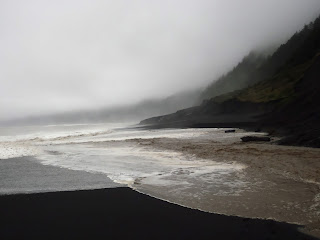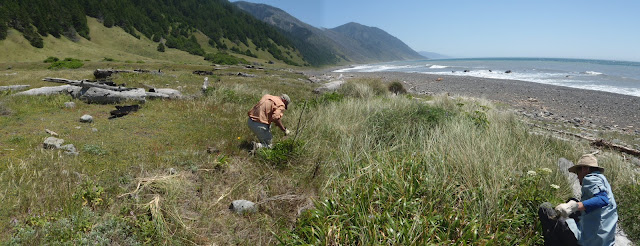We had another great summer here in the King Range National
Conservation Area with over 4,800 visitors this year – the majority of which
travel on the Lost Coast Trail for at least a portion of their trip. It’s been
a while since I’ve posted and there are a few things to update you about:
1. Fire Restrictions
2. LNT – specifically, Dispose of Waste Properly
3. Bears
With the onset of the rainy season we are no longer in
campfire restrictions. Burn as you will but if you decide to have a campfire
please help maintain clean campfire rings and fire safety.
Use existing fire rings when possible and keep your campfire
small. Building large fire rings encourages the burning of larger pieces of
wood and this tends to break down the ring and spread ash outside it's perimeter. This leads to an eye sore for other visitors and encourages them to
build another fire ring - multiplying the impacts.
Please pack out your trash and do not burn it in your
campfire unless it can be completely burned in one sitting and you plan to do
so. Examples of things that often do not burn completely in one sitting:
Anything lined in foil (e.g. Mountain House packaging), metal cans, plastics,
and food scraps (e.g. orange peels, egg shells).
Be sure to always have someone present to watch over/tend
the fire and have plenty of water nearby to extinguish any rogue flames. To extinguish your campfire soak it with plenty of water and
stir. Smothering with sand doesn’t put the fire out completely and when the
wind picks up it blows the sand off leaving a potentially hazardous situation.
Also, this fills the ring with sand which in time makes the ring undesirable/unusable
and encourages others to build new campfire rings – spreading the impact (see picture above).
With all that being said let the smell of the campfire
saturate into your jackets this winter.
To switch gears a bit, what kind of waste do you produce in
the backcountry? To name a few, human waste, food scraps from cooking and
wrappers and other garbage associated with food items. The picture below is the
average amount of trash that I pick up along the Lost Coast Trail as well as in
and around campsites/fire rings. Is this really necessary?

After I stop for a snack I walk a few feet and look back
where I was just sitting to make sure I didn’t forget anything – including small
pieces of trash. This is a good method to help forgetful people (myself
included). Unfortunately, there’s a high percentage of trash that I can tell is
left behind intentionally – often stuffed in a campfire ring or scattered
around a campsite. I fail to understand how one would visit such a beautiful
place as the King
Range and leave their
trash here for others to “enjoy.” One
may think, “hey, this can burn, I’ll just leave it here for the next person.”
But, you’re not doing anyone any favors leaving your trash behind, really. This
becomes an unsightly mess for the next person. The best we can do is to leave
an area as pristine as possible. Or, as I learned as a Tiger Scout: Leave a
campsite better than how you found it.
Another kind of waste is toothpaste. I’ve seen several
different methods to dispose of this after brushing. Some like to take a mouth
full of water, swish it around a bit then blow it out in a wide spray/spit to
disperse it. I’m not the biggest fan of this method. When I’m out on the Lost Coast
Trail I spit my toothpaste into the ocean. Not into the creek that will soon go
into the ocean, but directly on the sand where the waves are breaking.
In fact, I also go down to the ocean to wash my dishes. I
will get some water from the creek, grab a handful of sand and walk at least
15-30 feet away while I scour my cook wear with the sand. I’ll then dig a small
hole in the wet sand and bury the waste or toss it directly into the crashing
waves. I always plan my meals carefully to minimize food waste as much as
possible. If there’s a good portion of food left that I can’t eat I will pack
it out (plastic bags and back into the bear canister).
What about human waste? When you need to dispose of solid
human waste on the LCT dig a hole
6-8 inches deep in the wet sand below the high tide line (or as close to the
wet sand as safely possible), make your deposit and then cover the hole with
sand.
There are 4 goals with human waste disposal in the
backcountry:
1. Minimize contact with water sources
2. Minimize contact with insects and wildlife
3. Minimize social impacts. This is the disgusting factor
when you see a pile of waste right next to where you are camping.
4. Maximize decomposition (when we bury it 6-8 inches it
maximizes decomposition by mixing with the soil and microbiological organisms.
Putting a 6-8 inch rock on top of it is not burying it).
The steep and rocky cliffs along the trail and at the major
drainages/camping areas make finding a place to go 200 feet away from
campsites, trails, and drinking water sources (standard Leave No Trace
practice) nearly impossible – therefore, we have found that the ocean is the
most ideal place to dispose of human waste.
I was talking to these nice campers one night this summer
then noticed the toilet paper and waste behind them. They apparently set up
camp and started cooking before they noticed the mess - I promptly cleaned it
up as I pondered to myself how someone could leave a mess like this for their
fellow backpackers.
If for some reason you absolutely can’t go down to the beach
to take care of business PLEASE go at least 200 feet from campsites, trails,
and drinking water sources and BURY your waste! Every so often I find that
people bury their turds but then leave their toilet paper on top of the soil
and then put a rock on top. Please completely bury your toilet paper or pack it
out. There’s no need to leave it sticking out from under a rock like a little
flag. Is this some kind of a warning? I’m not sure.
Now, about the bears.
The bears in the King
Range are active all
winter and they DO come down to the beach – OFTEN! You must have an approved
hard-sided bear canister (see below) to store all food and scented items. This
includes canned food, dehydrated food, dog food, sunscreen, toothpaste,
deodorant, soaps, all trash associated with such items, etc. This picture below
is a bottle of sunscreen I found this summer – obviously ravaged by a curious
bear.
Please use a bear canister for the health and safety of the
bears and other wildlife (such as raccoons, which can be very aggressive).
Approved Bear Canisters:
Backpacker Model 812 (Garcia)
www.backpackerscache.com
BearVault 110b, 200, 250, 300, 350, 400, 450, and 500
www.bearvault.com
Bearikade Weekender MKII (1766 and higher) and Expedition
MKII (1766 and higher)
www.wild-ideas.net
The Bear Keg (Counter Assault)
www.counterassault.com
You will NOT find a sufficient tree to hang your food from
on the Lost Coast Trail.
If you do not have a bear canister you will receive a fine.
We rent out the Garcia bear can here at the BLM Project
Office in Whitethorn for $5 for your entire journey. You will need a credit
card and a drivers license (if you don’t return the bear can you will buy it).
We are open Monday-Friday 8-4:30.
You can also rent from the BLM Field Office in Arcata:
Monday-Friday 7:45-4:30.
You can also rent from:
Shelter Cove General Store
7272 Shelter
Cove Rd. Whitethorn
707-986-7733
Petrolia General Store
707-629-3455
HSU
Center Activities
707-826-3357
REI stores
I know that you know this is a special place – please treat
it as such.
I recently went to Olympic National Park to check out the
coastal trail, which was beautiful. At the trailhead I came across this sign
which I really liked the message of.
You can apply the same basic message for the Lost Coast
and every public land you visit.
Give me a call or send me an e-mail if you have any questions about the King Range NCA or any backpacking or Leave No Trace questions.
Your Wilderness Ranger,
Paul Sever
707-986-5405
lostcoastranger@gmail.com
PS:
.jpg)





































